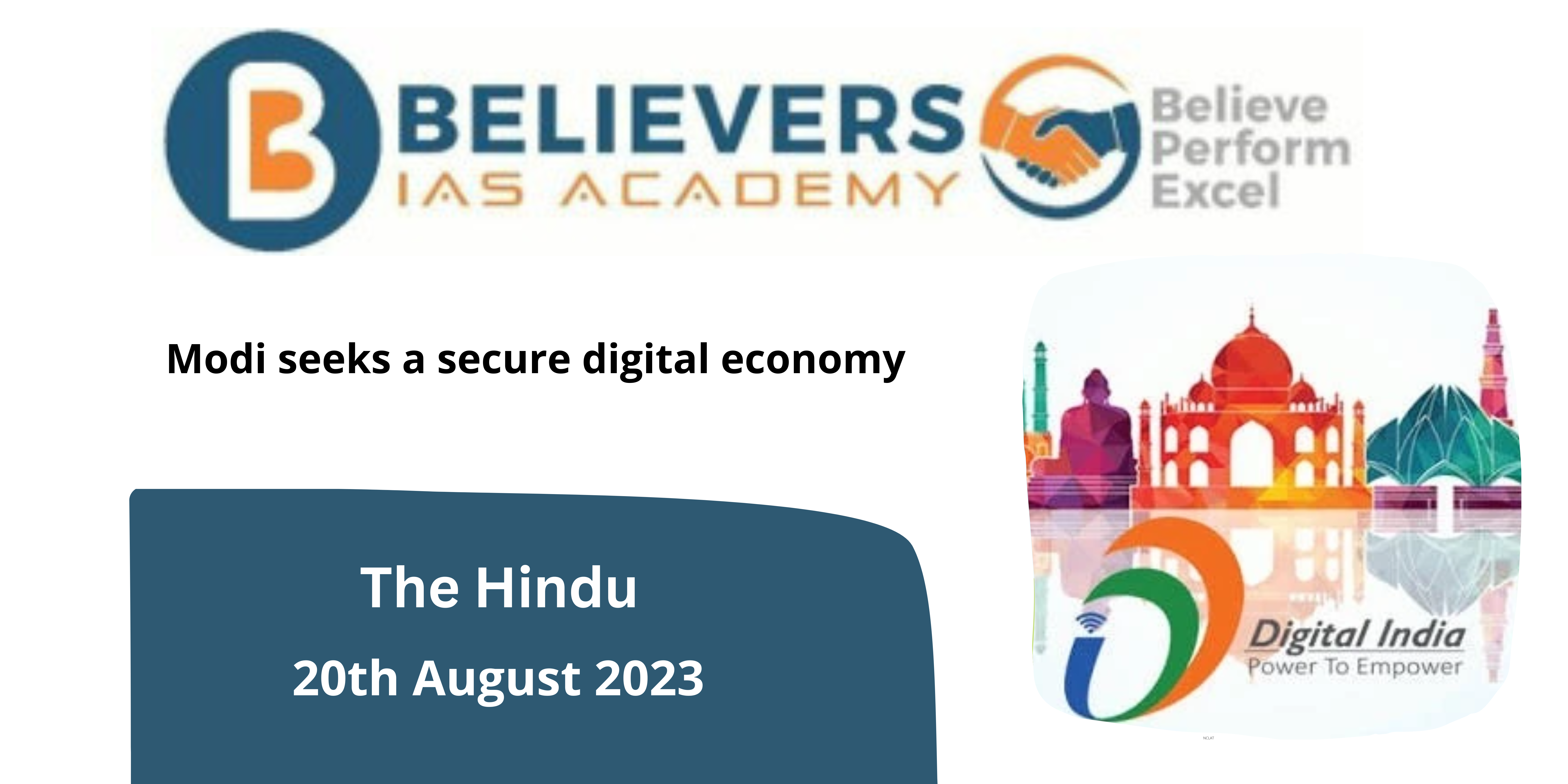Modi seeks a secure digital economy
Context
According to Prime Minister Narendra Modi on Saturday, the 2015 launch of the Digital India campaign was intended to increase financial inclusion across the country. Speaking virtually at the G-20 Ministers of Digital Economy meeting in Bengaluru, Mr Modi touted India’s diversity as a resource that supports the testing and development of new digital products from around the globe and stressed the importance of reaching an agreement on the “G-20 high-level principles for a secure, trusted, and resilient digital economy.”
What is Digital India Campaign?
The Government of India has started a program called the “Digital India Campaign ” to change the nation into a knowledge-based society and economy. On July 1, 2015, Prime Minister Narendra Modi gave the campaign its official start. Its main goals are to use digital technology to increase citizen digital literacy, expand citizen access to government services, and improve digital infrastructure.
What are the key objectives of the campaign?
- Digital Infrastructure: Increasing high-speed internet connectivity, particularly in rural and remote locations, to improve the digital infrastructure. This entails building broadband networks and enhancing nationwide digital accessibility.
- Digital Services: Improving civilian access to government services through online channels. To make it simpler for citizens to access these services without the requirement for physical presence, this also covers the digital delivery of services like healthcare, education, financial services, and more.
- Digital Literacy: Promoting digital literacy and ensuring that every citizen has the knowledge and abilities to use digital technology successfully. To close the digital divide and guarantee that members of all societal groups may profit from the digital revolution, this is essential.
- Digital Empowerment: Giving citizens access to information, expertise, and resources that can enhance their lives and livelihoods through digital methods is known as “digital empowerment.”
- Digital economy: the promotion of digital technology to spur innovation and economic prosperity. This involves helping startups, promoting innovation across many economic sectors, and encouraging digital entrepreneurship.
- Cybersecurity: enhancing cybersecurity measures to guarantee the security and protection of digital platforms and transactions from online dangers.
What is the digital economy and what are the challenges faced by the Digital Economy?
The economic activity that is supported by digital technology including the internet, mobile devices, and digital platforms is referred to as the “digital economy.” JAM (short for Jan Dhan-Aadhaar-Mobile) trinity refers to the government of India’s initiative to link Jan Dhan accounts, mobile numbers and Aadhaar cards of Indians to plug the leakages of government subsidies. The digital economy has many advantages, but some security issues need to be resolved as well. The following are some significant security issues the digital economy is facing:
- Cybersecurity Threats: The digital economy is susceptible to a range of cyber threats, including ransomware assaults, phishing scams, data breaches, and cyberattacks. These dangers may endanger private information, interfere with services, and result in losses of money.
- Concerns about data privacy: There are worries about data privacy and how this information is utilized by companies as more sensitive and personal information is gathered and processed in the digital economy. Identity theft, fraud, and other privacy-related problems can result from data breaches.
- Intellectual Property Theft: Digital technologies make it simpler to exchange and distribute content, but they also make it easier for people to copy and distribute intellectual property, such as software, corporate data, and copyrighted content, without authorization.
- Digital fraud: Online transactions and e-commerce platforms offer opportunities for a variety of fraud types, including money fraud, credit card fraud, and online con games that prey on both individuals and companies.
- Legal and Regulatory Obstacles: The fact that the digital economy transcends territorial boundaries might make it difficult to comply with many rules and legal frameworks. Conflicts over jurisdiction, taxation, and compliance may result from this.
- Security Concerns with IoT and Smart Devices: As Internet of Things (IoT) devices and smart technologies proliferate, new security concerns arise. If these devices are not properly secured, they may be open to attacks, which could result in breaches and unauthorized access.
- Insider Threats: Insiders, such as workers or contractors, may act maliciously or carelessly, posing a serious security risk. Data breaches, the theft of confidential information, and other security events can all be caused by insider threats.
- Digital identity and authentication: It’s essential to guarantee secure and trustworthy digital identity verification and authentication to stop identity theft and unlawful access.
What is Bhashini?
- An AI-driven tool for language translation is called Bhashini, which stands for BHASa INterface for India.
- Prime Minister Narendra Modi introduced it in July of the year before (the year is not specified in the provided text).
- The Ministry of Electronics and Information Technology is in favour of the proposal.
- Bhashini intends to make language translation easier between different Indian languages so that a larger audience may access and understand digital material.
- The platform makes use of artificial intelligence to offer language translation features, which helps create a more diverse online environment.




